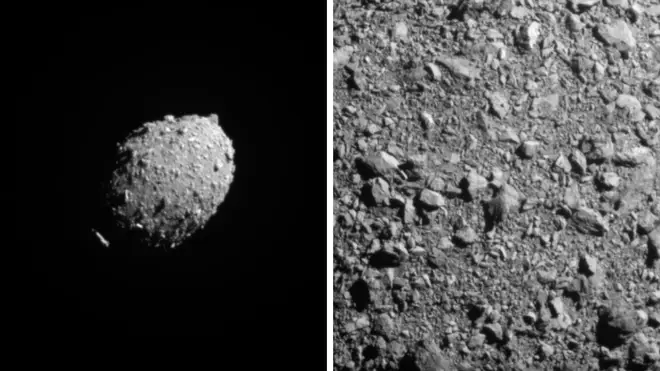
James O'Brien 10am - 1pm
4 April 2024, 10:10

A Nasa mission that knocked an asteroid off course in 2022 created debris that will punch craters in Mars, scientists believe.
The Double Asteroid Redirection Test (Dart) slammed a spacecraft into a small asteroid to look at the possibility of defending Earth from outer space.
The asteroid - named Dimorphos - posed no threat to Earth. But the aim of the mission was to demonstrate that dangerous incoming rocks can be deflected by deliberately smashing into them.
The test exceeded expectations, with Nasa tweeting "IMPACT SUCCESS!" after the collision.
But a study has revealed 37 boulders that blasted off Dimorphos could lead to meteor storms on Mars - in 6,000 years time.
"All the observations taken so far prove that Dart has been a successful test for asteroid deflection since it managed to change the orbital period of Dimorphos and it did not create any boulder that could impact on Earth," a paper by Italian astronomers Marco Fenucci and Albino Carbognani said.
"On the other hand, the findings presented in this work suggest that future missions involving an interaction with the surface material of a near-Earth asteroid shall be carefully planned."

Nasa tests defence technology by crashing spacecraft into asteroid
The pair used observations taken by the Hubble Space Telescope of Dimorphos as well as Didymos to study the boulders ejected in September 2022.
The boulders, which measured between four and seven metres, could become obstacles for the European Space Agency's (ESA) Hera spacecraft which is set to reach Dimorphos in 2026.
But the scientists also found that in the long term their orbits intersect that of Mars.
“Numerical simulations show that all the boulders of the swarm will cross the orbit of Mars multiple times in the future 20,000 years … it is possible that some of the boulders will impact Mars,” the paper said.
It added: “Given the rarefication of the Martian atmosphere, we expect the boulders to arrive intact on the ground and excavate a small impact crater.”
The craters could be up to 300 metres in length.
The scientists said more care needs to be taken in terms of the the long-term dynamics of any material ejected from asteroids on future missions.
“This would be particularly important for private asteroid mining missions because near-Earth asteroids orbiting closer to the Earth represent the optimal targets to maximise the cost-to-profit ratios of such missions,” they said.